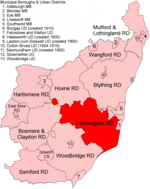Rendlesham

Rendlesham is a village and civil parish near Woodbridge, Suffolk, United Kingdom. It was a royal centre of authority for the king of the East Angles. The proximity of the Sutton Hoo ship burial may indicate a connection between Sutton Hoo and the East Anglian royal house, the Wuffingas. The king of Essex, Swithhelm (son of Seaxbald) who reigned from 660 to around 664, was baptised at Rendlesham by Bishop Cedd with King Æthelwold of East Anglia acting as his godfather. He died around the time of the great plague of 664 and may have been buried at the palace of Rendlesham. An archaeology project has identified a large settlement of more than 124 acres (50 hectares).Its name is recorded in Old English about 730 AD as Rendlæsham, which may mean "Homestead belonging to [a man named] Rendel", or it may come from a theorized Old English word *rendel = "little shore". The Church of St Gregory the Great in Rendlesham is a Grade I listed medieval church. Rendlesham Hall, a large manor house, was demolished in 1949.Rendlesham Forest, owned by Forestry England, is a 1,500-hectare (3,700-acre) mixed woodland with recreation facilities for walkers, cyclists and campers. It is part of the Sandlings Forest Site of Special Scientific Interest. The Rendlesham Forest incident was a series of reported sightings of unexplained pulsing lights off the coast of Orford Ness in December 1980. During the summer of 2012, scenes of the movie Fast & Furious 6 were filmed on the former RAF Bentwaters airfield.
Excerpt from the Wikipedia article Rendlesham (License: CC BY-SA 3.0, Authors, Images).Rendlesham
Sycamore Drive, East Suffolk
Geographical coordinates (GPS) Address Nearby Places Show on map
Geographical coordinates (GPS)
| Latitude | Longitude |
|---|---|
| N 52.13 ° | E 1.4136111111111 ° |
Address
Sycamore Drive
Sycamore Drive
IP12 2AH East Suffolk
England, United Kingdom
Open on Google Maps










